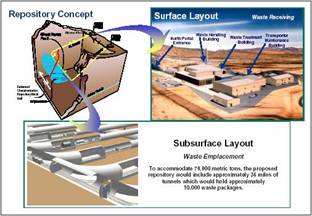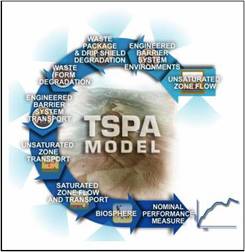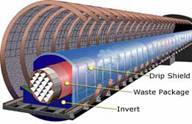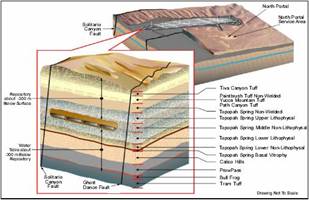Geology and Natural Heritage of the Long Valley Caldera
Yucca Mountain: A Sitting Bomb or a Secure Repository?
Amy Ficken
Why does the United States of America need a nuclear waste repository? Is it safe to bury nuclear waste underground? What makes a Geological Repository the best for storing nuclear waste? Why is Yucca Mountain the best place to build a repository? These are some of the questions that American citizens have about nuclear waste. Some Americans support the building of the repository at Yucca, and others are very opposed. However, no matter what side is being discussed, both agree that something must be done with the nuclear waste that is residing in our nation today. This issue must be dealt with, because the solutions in use today for the nuclear waste problem are only temporary. In fact according to the U.S. Department of Energy, DOE, there are 131 temporary holding tanks in 39 states. These tanks are not all in remote areas either, some are in the most metropolitan areas our nation has. For example, on a DOE map of temporary sites, it shows that there are numerous nuclear waste tanks in the New York and Chicago areas. There needs to be a long term solution, because the waste is going to remain radioactive and therefore harmful to humans and the environment for thousands of years. Currently, the nation has decided to build a permanent storage facility for the waste in an underground repository. It will be located in Nevada beneath Yucca Mountain which is approximately 100 miles from Las Vegas. The site was chosen for many reasons: it is an arid and rural area, it is located where there is an extremely low water table, and many other geological reasons which are going to be discussed in detail. [Why Yucca Mountain , 2003] I believe that Yucca Mountain is the best option for disposing of the waste, and that the repository will contain the waste safely for the ten thousand years as it is required to do.
Figure reproduced from www.ocrwm.doe.gov/pm/program_docs/annualreports/00ar/00ar-cl.htmAlthough, as mentioned before, not everyone believes that a geological repository at Yucca Mountain is the best option. Moreover, not everyone believes it will meet the ten thousand year containment law that the government requires. People opposed to the repository include groups such as the Natural Resources Defense Council, NRDC, the State of Nevada and especially Senator Harry Reid, and groups like Citizen Alert in Nevada . The groups mentioned are dissatisfied with many aspects of the current solution to the nuclear waste problem, but all the problems have to do with keeping people safe from the harmful side effects of the waste. Water contamination is a big concern for the NRDC and other opposers of the Yucca Mountain repository. They believe that the Environmental Protection Agency, EPA, has given false predictions for groundwater safety. In addition, they believe proof for this lies in the fact the EPA extended the 3.1 mile oval around Yucca Mountain by 11 miles in the lower right section of the restricted area. Since the extension is in the direction that groundwater flows, the NRDC believes that this was done to ensure that the radioactive waste that does reach the water table will be diluted enough to meet standards set by the government. [Drinking Water Protection Law, 2002] In addition to the radiation that will be released from Yucca through groundwater contamination, the NRDC also believes that more radiation will be released from transportation accidents. The waste will travel to Yucca by way of road and rail. These people feel that transporting the waste in such a way is very dangerous because of the risk of accidents and therefore the release of the nuclear waste. The NRDC took the EPA to court for underestimating the radiation exposure that will be released from Yucca and for issuing insufficient environmental and public health standards. Believe it or not, they won the case! The court ordered the EPA to rewrite the standards that were inadequate and make the repository meet the new standards. [Yucca Mountain Court Case, 2004] Another concern related to transportation is terrorism. The NRDC feels that terrorists will make use of the waste to wreak havoc on American soil. The last big concern that opposers of Yucca Mountain have is the seismic activity on the Yucca Mountain site. They are concerned that the water table could rise by as much as 800 feet from quakes, and that the tuff the repository is being constructed in can be fractured by quakes. These fractures would allow water to flow much easier into the repository. The NRDC claims that two chemicals that were shot into the atmosphere during nuclear weapons tests in the 1950s were found in tunnels a few hundred yards beneath the Yucca Mountain surface. They suggest that this disproves the EPA's water filtration predictions, because the chemicals have penetrated into the mountain by hundreds of yards within 50 years. [Forest , 2002]
In addition to having to rework the predictions and standards the courts ordered the EPA revise, the DOE announced in March that some of the data from water infiltration predictions and climate studies may have been falsified. The DOE found e-mails from a Geological Survey employee indicating that he changed the data. The e-mails were discovered when the DOE was gathering data for applications that would allow the repository to start collecting waste. These two large and unexpected set backs have put the DOE behind in its plans for the repository. It announced in the same article that the repository would not be open to receive waste by 2010 as was expected. [Falsified Data, 2005] This scandal seems to be rallying the troops to discover what else, if anything, the EPA and DOE are hiding or lying about. All in all, the NRDC and organizations that are against the Yucca Mountain repository believe that water is the biggest culprit for releasing radiation once the waste is in the repository. They are taking action against the EPA to make better standards and more reliable predictions about the future climate and how the facility will perform against time. As seen above, these organizations, mainly the NRDC, are succeeding.
Despite these problems presented by the NRDC and fellow opposers, the government has decided to pursue the Yucca Mountain repository. They have done so for many geological reasons and have put prevention and protection strategies in place to combat the deficiencies the Yucca Mountain repository has. Some of these strategies are developed for transportation and terrorism issues, as well as water contamination and seismic impact in the repository. There are numerous strategies that have been developed to keep the waste safe during transport. First, before the waste is shipped, it is transformed so that it is stable and solid and is incapable of burning, leaking, and exploding. In addition to the transformation, the waste will be held in stainless steel casts and contain other materials like lead for extra shielding. These characteristics are constant for both rail and truck transport, with rail transportation preferred. The Nuclear Regulation Commission, NRC, and DOT will be responsible for the waste when it is being transported to the Yucca repository. They will have specially trained inspectors that will make sure the waste is in proper condition before it leaves the temporary facility, at check-points, and before it enters the repository. At most, there will be 70,000 metric tons of nuclear waste shipped to the repository . [Transporting to a Repository, 2002] The government has already transported waste over the past 24 years, 3,200 rail and 1,100 truck movements. In all these movements of waste, there have only been eight accidents, four to each, and none resulted in a nuclear waste spill. [Why Yucca Mountain , 2003] Besides these transportation requirements, there are also additional precautions to protect against terrorism. The NRC has developed a few key concepts in this area: all shipments are escorted, there is monitoring 24 hours a day through a communication headquarters, and schedule information for the waste is kept only told to state governors and local law enforcement. [Transporting to a Repository, 2002] Scientists are using computer generated models to predict how the repository will hold up over time. They have determined that the most likely way for the waste to escape is for it to contaminate the water around the mountain. As a result, they have constructed a unique system that uses the mountain's geological characteristics
Figure reproduced from www.ocrwm.doe.gov/pm/program_docs/annualreports/00ar/00ar-cl.htmand man-made devices that work together, but operate independently of each other. This way, if one system becomes damaged, the repository will still be safe because the damaged system won't damage the others as well. Some of the engineering that is going to be instilled in the repository are just in the waste packages themselves. An inner steel cylinder around the interior of the waste package is made to maintain the shape of the container. This feature would be important if the containers were shifted by seismic activity. The outer part of the package is made of an alloy which resists corrosion. Then in the rooms where the containers are kept there are also some features which have been designed to keep the waste separated from the water that might drip down to the repository in the distant future. [Geo. Repository Design, 2001] First there are titanium drip shields/roofs over the areas where the containers are. Then the containers are placed on metal pallets to keep the waste off repository floor. Last, the engineers lined the floor with a combination of metals, mostly steel, inverts. All these designs were created to resist corrosion and keep the water that might enter the repository separated from the waste. [ Yucca Mountain Project, 2001]
Figure reproduced from www.ocrwm.doe.gov/ymp/science/engdesign.shtmlThere are also many geological features that make Yucca Mountain the best site for a nuclear waste repository. Perhaps the most obvious reason is that the mountain is located in one of the most arid places in the nation. On average the mountain receives 7.5 inches of any type of precipitation per year, and only five percent of that amount actually seeps underground into the mountain. This low percentage is due to water run-off down the mountain, the vegetation using the water, and the high evaporation rate. This small amount of precipitation moves through the unsaturated area of the mountain first. This is the area above the water table. It moves through this area using fractures in the rock which are usually the result of past seismic activity. The water can also move through the mountain utilizing the few rock pores Yucca Mountain has. These are the only ways that water can get below the surface because there are no permanent bodies of water on the mountain that water can seep through. [Why Yucca Mountain , 2003] Below the water table in the saturated zone the water moves through the same means. However, the water coming down through Yucca Mountain would meet up with other water sources. When the waters meet, it is called the dilution process. The process is simply the waters mixing together and moving with the existent groundwater in the direction of easiest flow. One of the great benefits of building a repository at Yucca Mountain is the fact that the water table is nearly 2,000 feet below ground. This is one of the deepest water tables around. Having a deep water table is important because if the water does come in contact with the waste and become contaminated, it will take a long time for the contaminated water to reach the water table. Another important feature of the mountain that protects the waste from water is the fact that Yucca Mountain is composed of mostly welded and non-welded tuff. [Why Yucca Mountain , 2003] From the surface down, this is the order of the tuff that makes up the mountain: the Tiva Canyon Welded tuff, the Paintbrush non-welded tuff, and the Topopah Spring Welded tuff. The repository will be located in the Topopah Springs tuff. Below the proposed repository there is Calica Hills Non-Welded formation and the Crater Flat Semi-Welded group. [Geo.Repository Design, 2001]
Figure reproduced from www.ocrwm.doe.gov/pm/program_docs/annualreports/00ar/00ar-cl.htmKeep in mind that according to the USGS, that tuff is an igneous rock that is made up of ash fragments that have been compressed together. If the ash particles are at a high temperature when they are compressed, they fuse together and form welded tuff . [USGS Geology, 2005] This implies that welded tuff is essentially one rock. Much of Yucca Mountain is welded or at least semi-welded tuff, so it is very strong and hard to penetrate. There is another feature in some of the layers of tuff that was extremely appealing for holding nuclear waste. Especially the Calico Hills formation, directly below the repository site, which contains a great amount of a certain mineral called Zeolite. Zeolite is a unique mineral that has the ability to separate radionuclide from stable ones and hold the radionuclide while the rest of the particles move passed. This provides extra protection in case water would seep through the repository and pick up radionuclide on its way down to the water table. [Geo. Reference Design, 2001] Two disadvantages of building at Yucca are the fact that Yucca is on numerous active faults, and the mountain is near a volcanic area. Scientists believe that the seismic activity the mountain experiences will not affect the repository for two reasons: the repository is being built deep underground on a stable rock bed, and engineers are experienced in building things that can withstand the movement of earthquakes. [Earthquakes, 2003] Volcanologists have also studied the area and determined that the chance of volcanic activity around the mountain is extremely small. They studied past activity and computer models to come to this conclusion. [Why Yucca Mountain , 2003] All of the geological information about the repository was in packets issue by the government and written specifically by the DOE.
However, on March 16, 2005 the DOE released some very disturbing information. They reported and admitted that some of the information that had been published was false. The information falsified by a geological surveyor working on the Yucca Repository project was in the water infiltration and climate prediction data areas. It seems that both data sets were purposely made better to insure that Yucca would be selected as the nation's nuclear repository. Even though the DOE claims that they did not know the data was altered, they are responsible. The DOE discovered e-mails from 1998-2000 that indicated the data had been altered by the Geological Survey employee, and after further pursuing the issue the discovered that they data was altered. [Falsified Data, 2005] It looks like this information may have given the opposers of the Yucca Repository the arguments they needed to keep the repository from being built. The Senate Democratic Leader and Senator of Nevada, Harry Reid, was quoted as saying this on the 16 th of May “This proves once again that the DOE must cheat and lie in order to make Yucca Mountain look safe….It is abundantly clear that there is no ‘sound science' at Yucca Mountain .” [Reid Statement, 2005] Then on June 13, I was watching T.V., and I saw Senator Reid on CSPAN2 talking about the repository. I came in on a question and answer session with the senator and a reporter asked if Yucca Mountain was dead. The senator responded like this after a slight pause, “No, it is not dead…but it is on a breathing machine.” Later in the question and answer session he eluded to the fact that the nation needs to develop another idea for permanently disposing of the nuclear waste the US has generated.
Before I learned about the falsified information and the lies the DOE has published about the site, I was completely for the building of a nuclear waste repository at Yucca Mountain . Now I am not sure what is accurate information and what is not. Therefore, I am not sure if I want the repository to be built or not. The issues that the DOE lied about, water infiltration and climate predictions, are, in my opinion, the most important. I feel that way because both of the areas increase the chance of water disturbing the waste and carrying the waste outside of the repository. Both the DOE and the NRDC agree that water carrying the waste is the most likely way that the waste could escape. That is why it is so disturbing that the DOE lied and said that Yucca allowed less water than it really does underground. They also lied about climate predictions, and although I am not sure what exactly the DOE changed in this category, I believe that they lied to make the repository look safer. I am interested on following this story to find out what is going to happen to all the nuclear waste our nation has produced over the past 50 years.
Sources:
-
Drinking Water Protection Law: Environmentalists and State of Nevada Say Yucca Mountain Radiation Standards Violate Drinking Water Protection Law. Ed. Cochran, Thomas B.. May 2002. NRDC 13 June 2005 http://www.nrdc.org/media/pressreleases/020506.asp .
-
Earthquakes: United States . Department of Energy, Office of Civilian Radioactive Waste Management. Studying the movement of rock and earthquakes. Washington : GPO, 2003
-
Falsified Data: Yucca Mountain Scientific Data May Have Been Falsified .
16 March 2005. NRDC 13 June 2005 http://www.nrdc.org/bushrecord/articles/br_1913.asp?t=t. -
Forest , David . “Burial Ground.” On Earth Online Summer (2002) http://www.nrdc.org/onearth/02sum/burial1.asp.
-
Geo. Repository Design: United States . Department of Energy, Office of Civilian Radioactive Waste Management. Reference Design Description for a Geologic Repository . Washington : GPO, 2001
-
Reid Statement: Reid Statement on Falsification of Yucca Mountain Documentation . 16 March 2005. Senate Democratic Communications Center 14 June 2005 http://reid.senate.gov/record2.cfm?id=233737.
-
Transporting to a Repository: United States . Department of Energy, Office of Civilian Radioactive Waste Management. Transporting Spent Nuclear Fuel and High- Level Radioactive Waste to a National Repository . Washington : GPO, 2002
-
USGS Geology : Tuff. 13 June 2005 http://geology.wr.usgs.gov/docs/parks/misc/glossaryt.html .
-
Why Yucca Mountain : United States . Department of Energy, Office of Civilian Radioactive Waste Management. Why Yucca Mountain ? . Washington : GPO, 2003
-
Yucca Mountain Court Case: EPA Loses Yucca Mountain Court Case . 9 July 2004. NRDC 13 June 2005 http://www.nrdc.org/bushrecord/articles/br_1688.asp?t=t
-
Yucca Mountain Project: United States . Department of Energy, Office of Civilian Radioactive Waste Management. Yucca Mountain Project . Washington : GPO, 2001



